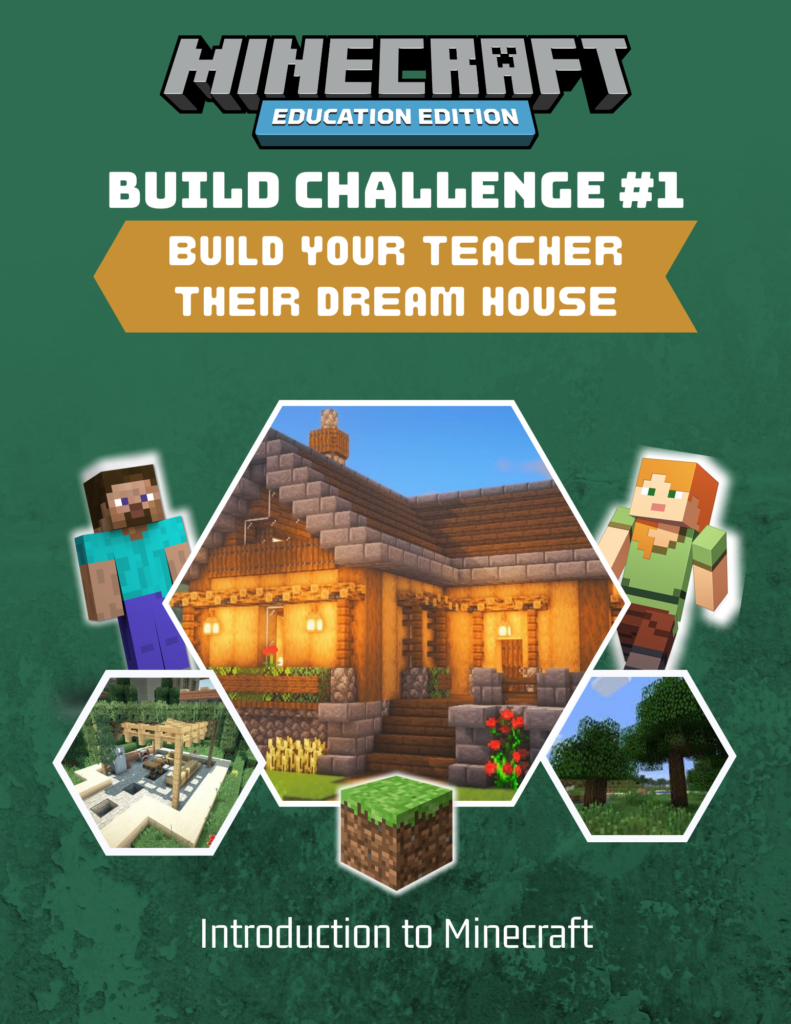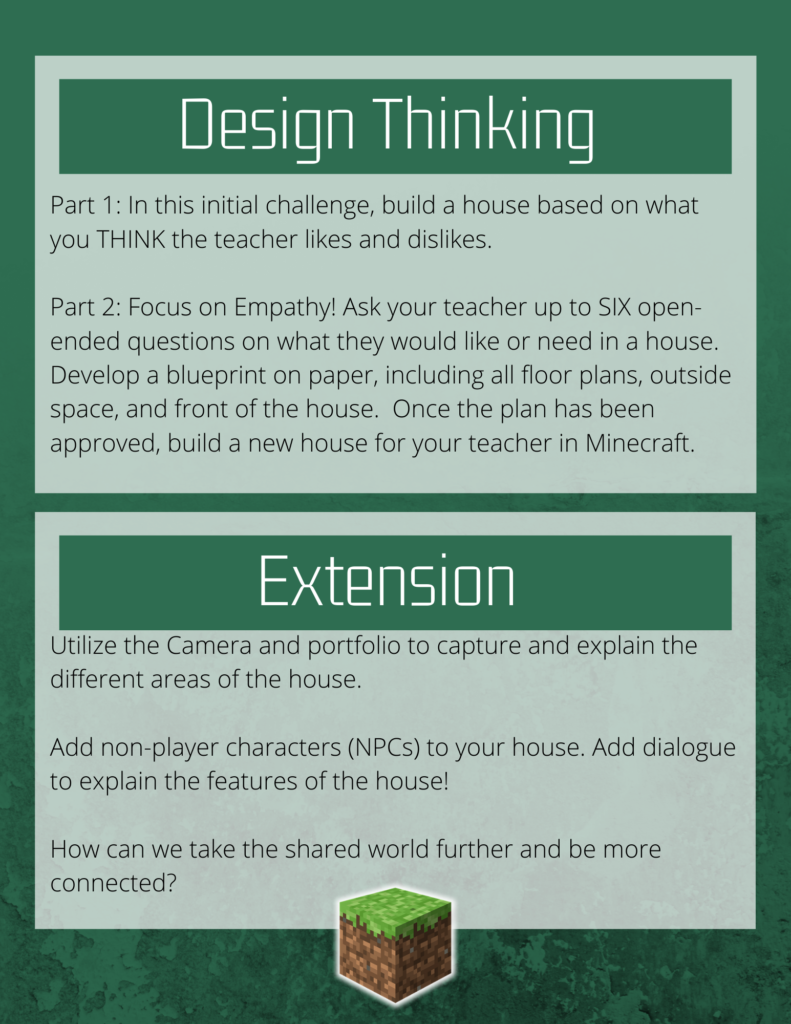*This post has been cross-posted with Curtis Bourassa.
During EC&I 834 last week, Dr. Couros put us into breakout rooms so each person could share the first module of their course prototype and we could give feedback on each other’s courses. We received both positive and constructive feedback, which is already helping us rethink decisions and adjust our planning. Thank you to everyone who shared their questions, comments, and suggestions with us!

Positive Feedback and Affirmations
Some of the positive feedback we received included:
- Having students represent their learning in Minecraft Education Edition seems highly engaging and fun.
- Including detailed notes in the lesson plans is helpful for teachers who don’t have an in-depth knowledge of the Treaty outcomes themselves.
- Teaching this course as we construct it is a great way to test out the lessons and build challenges so we can improve the course as we go.
- Creating the build challenges in Canva is visually appealing and provides another resource for teachers to take and use.
Constructive Feedback
Re-Evaluating our LMS Choice
As other people were commenting in the class Discord, there seemed to be a common theme of difficulty sharing with our school division’s preferred LMS. Many groups using Microsoft Teams were having difficulty sharing their course with the class, including us. Although it is possible to add a guest to a Microsoft Team, we determined that the steps required to access our course are difficult to navigate if the user has limited Microsoft Teams knowledge. We were recommended to use WordPress to provide easier access to the people we are sharing our course with. WordPress will allow us to share our course openly at the National Congress on Rural Education when we present at the end of March. We were also recommended to purchase the domain for our website but have decided to hold off until we establish the site further.
These are some of the main reasons for the inclusion of WordPress:
- Easier navigation,
- Visually appealing and clean,
- Easier to openly share the resource,
- Provides ability for others to download and use the resource with their own classes
However, because we are currently using the course in three classrooms that are comfortable using Microsoft Teams, we have decided to continue to use Microsoft Teams and Class Notebook with them. We will use WordPress to share the content with people outside our school division.
Re-Structuring our Modules
We are currently teaching these lessons to three different classes: a Grade 6/7 and Grade 7/8 classroom in Carievale and a Grade 7/8 classroom in Bienfait. The classes have different levels of experience with Minecraft Education Edition and different levels of prior knowledge about the Treaties, so we will definitely need to differentiate for each class.
After teaching Lesson 3: Intro to the Treaty Relationship to one of the classes, we realized we might need to slow down and break topics down more. We decided to restructure our modules to ensure each lesson and corresponding build challenge focused on one topic at a time. For example, instead of teaching a lesson on Reasons for Making Treaties for the First Nations and the British Crown, we broke it down into two parts:
- Reasons for Making Treaties – First Nations Peoples
- Reasons for Making Treaties – British Crown
Here is what we came up with for our re-structured overview:
Synchronous vs. Asynchronous Content
Currently, this is a blended course with synchronous instruction along with recorded instructional videos for students to access if needed. So far, we have created two Minecraft tutorial videos for students, which can be found here.
One question we asked for feedback on was: Do you think we should include some instructional videos on the Treaty Ed/Social Studies lesson content? Or is it okay not to since we are planning to teach those lessons synchronously?
Dr. Couros said we could include some Treaty Ed/Social Studies lesson videos as a scaffold for teachers if we wanted to, but he cautioned that we wouldn’t want teachers to just take an entire course of video lessons and use that content with their students. He reflected that this content is something teachers need to dig into and teach themselves, as it is much more impactful for students if these lessons come from their own teacher.
We agree with this feedback and will continue with our plan to teach the lessons synchronously! We might record one lesson or part of a lesson just to share an example, but most of the recorded videos will be tutorials that walk students through different Minecraft skills.
Extension Opportunities
Some of the feedback we received is how we can provide extension activities for our students. Dr. Couros gave us a suggestion of looking at the Mojang Commercial Usage Guidelines. These guidelines would provide excellent opportunities to discuss Digital Citizenship, the importance of looking at data privacy, and terms and conditions.
Another suggestion was the opportunity to explore literacy connections through Minecraft and Treaty Education. Minecraft has become increasingly popular and has extended passed just being a game. There are numerous books that have been written with Minecraft characters and Minecraft worlds as settings. Students could explore Treaty Education and Minecraft in fan fiction writing.
Students could also learn how to code using the code builder within Minecraft. These coding skills could be applied to help students build their creations more efficiently and learn 21st-century skills.
Authentic Representation
Another suggestion from the class was that we need to be aware of authentic representation. Within Minecraft it will be difficult to represent an authentic view of Treaties due to the characters that can be used in the game. The image below highlights some of the choices of characters to be used as NPCs (non-player characters).
In our search to find characters that could be better to reflect diversity in Minecraft, we stumbled upon this post in the Minecraft Education Community.
I want to give feedback about the character options (skins?). Most of my students are Black and/or Latino and there is a very limited selection of characters who look like them. There are a few non-white characters in most of the skin packs but a few, including “Town Folk” and “City Folk”, are all white. Characters like the judge, lawyer, pilot, and scientist are only available in the lightest skin tone. I’m wondering what message this sends to my students and other Minecraft players.
Emma Wingreen
Similarly, we want our students to be able to build representations that avoid stereotypes and reflect accurate, respectful portrayals of Indigenous peoples and Treaty negotiations. We are looking into adding more Indigenous representation in our Minecraft worlds, including Indigenous languages and animals, plants, and trees relevant to our area in Saskatchewan. We know this is possible due to the recent world, Manito Ahbee Aki, which was released by Louis Riel School Division and Microsoft Canada in the middle of February.

They created an amazing immersive learning experience that celebrates Anishinaabe culture with extremely accurate representations of Manito Ahbee, “a site located in Manitoba’s western Whiteshell area, before European contact in North America”.
Thank you to everyone who provided this helpful feedback. If you have any comments, questions, or additional suggestions, please let us know in the comments!





Raquel, I think that it is so great that you used the feedback from your peers to incorporate another tool to make learning more manageable. I also like how you also used the same original LMS for the classrooms that you already started with, as they are comfortable with it, and need to use it to practice to keep their other subjects manageable (learning the ins and outs, etc.).
Because you ran out of time to share your course in your small group, were you able to get the feedback you wanted/needed from those that stayed after class? I enjoyed listening to you and Curtis speak on it together, as I was in the same group as Curtis and he was also last, and it’s interesting to see the different perspectives when presenting together.
Do you feel like you have things more organized using the website? Or do you still feel like there are things that you would like to reorganize or change?
Keep up the great work, I am excited to see the progress you two make.
Thanks Kelly! Yes, most of the classes we are working with use Teams pretty regularly. Some of them are less familiar with Class Notebook, but they are catching on quickly! We got lots of feedback at the end of class, which was really helpful.
I think WordPress will be easier to navigate than Teams/Class Notebook for the average person. We are just starting to move our content over to a WordPress site. I’m sure we will organize and re-organize as we add more content! We aren’t sure if we want our modules to show across the top menu with drop-downs for the teacher and student lessons, or if that will be too visually overwhelming. We’ll see – that might be something we need feedback on in the future!
Pingback: Culturally Responsive Pedagogy in the Online/Blended Learning Setting - Raquel Oberkirsch
Pingback: Treaty Ed and Minecraft Course Walkthrough & Reflections on Creation Process - Raquel Oberkirsch